- Home
- Florida History
- Florida Heritage Sites
- Florida Hurricane History
FLORIDA HURRICANE HISTORY
By Mike Miller Updated July 5, 2025
If you live in Florida for any length of time, you will probably either ride through a few major hurricanes or get the heck out of the way of one before it arrives.
Hurricanes - and their weaker cousin, the tropical cyclone - pose a significant threat to Florida, as the state's extensive coastline and geographic location make it particularly vulnerable to these devastating storms.
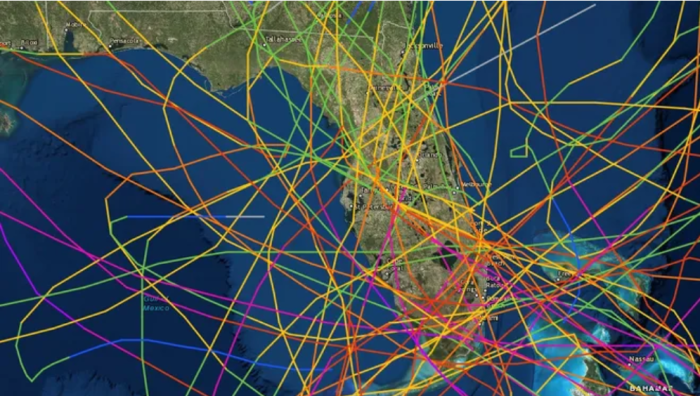 100 Years of Florida Hurricane Paths
100 Years of Florida Hurricane PathsNational Oceanic and Atmospheric Administration
The combination of powerful winds, torrential rainfall, and storm surges can lead to widespread destruction, uprooting trees, knocking down power lines, ripping roofs off homes, and causing massive flooding from heavy rains.
Hurricanes can also spawn tornadoes, adding another layer of danger to an already terrifying situation.
The chaos and destruction brought by hurricanes can leave communities in shambles, displacing residents and causing emotional turmoil for those who have lost their homes, belongings, and loved ones.
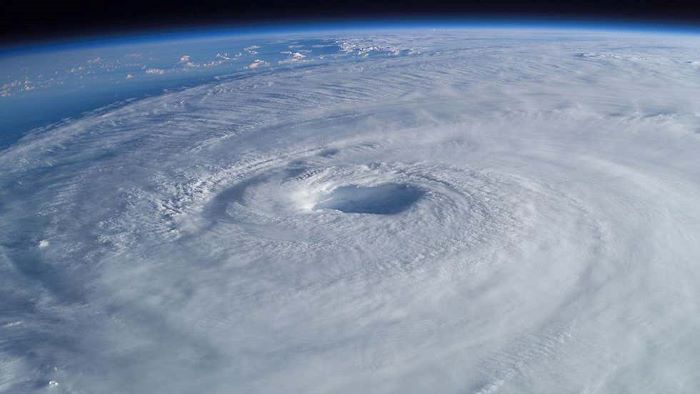 Hurricane Isabel Missed Florida
Hurricane Isabel Missed FloridaLandfall in NC Outer Banks
A hurricane warning or evacuation orders, if not heeded promptly, can leave people stranded in life-threatening situations. Key West and the other Florida Keys in Monroe County are quite often evacuated during potential hurricane threats.
In the midst of a hurricane, the deafening sound of strong winds, the relentless pounding of rain, and the darkness caused by power outages only heighten the terror experienced by those in the storm's path.
For many, the psychological impact of living through a hurricane can be long-lasting, with the mere mention of an approaching storm triggering memories of past traumas.
Many people who rode out Hurricane Andrew in Homestead suffered permanent hearing loss and now have such a fear of hurricanes they pack up and leave Florida if there is even a hint of a hurricane heading their way.
The typical Atlantic hurricane season runs from June 1 through November 30, but there have been some exceptions. We keep our eyes open for any tropical depression that develops in the Atlantic and hope it doesn't trigger a hurricane watch and impact our lives.
We have selected some of the most impactful hurricanes in Florida for our list.
MEMORABLE FLORIDA HURRICANES
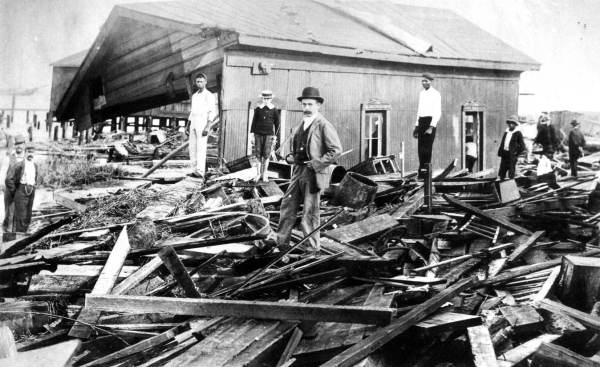 Damage from 1896 Hurricane, Fernandina Beach
Damage from 1896 Hurricane, Fernandina BeachFlorida Memory, State Archives of Florida
Cedar Keys Hurricane made landfall in the Cedar Keys on Florida's west coast on September 29, 1896 with a wind speed of 125 mph and a storm surge of 10.5 feet. It moved quickly over the state without losing much intensity and did extensive damage to homes and agriculture in North Florida and on the east coast.
Great Miami Hurricane made landfall in Miami on September 18, 1926. It was a Category 4 storm with wind speeds of 150 mph, storm surge of 10-15 feet, property damage of $105 million, and 372 lives lost. It became the beginning of the end of the great Florida real estate boom.
The Okeechobee Hurricane hit West Palm Beach on September 17, 1928, as a Category 4 storm. It had sustained winds of 145 mph, storm surge of 6-9 feet, property damage of $25 million in South Florida, and between 2,500 to 3,000 lives were lost. The damage and death from this deadliest hurricane was due to the overflowing of Lake Okeechobee. The storm effectively ended what was left of the Florida real estate boom.
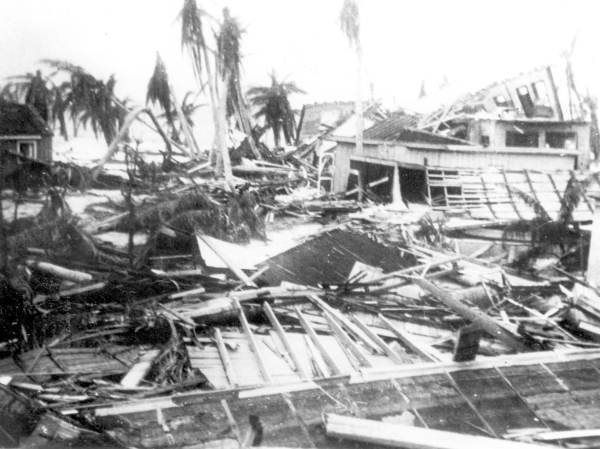 Long Key After the Labor Day Hurricane
Long Key After the Labor Day HurricaneThe Labor Day Hurricane struck Upper Matecumbe Key and other Florida Keys on September 3, 1935, as a Category 5 storm with wind speeds of 185 mph, storm surge of 18-20 feet, property damage of $6 million, and 408-600 lives lost. It is considered to be the strongest hurricane ever to hit Florida.
Hurricane Donna made landfall in Marathon on September 10, 1960, as a Category 4 storm with wind speeds of 145 mph, storm surge of 13 feet, property damage of $387 million, and 50 lives lost. It pounded Naples and swept across the state doing severe damage to areas along the Atlantic Ocean beaches. I was a new Florida resident and rode out the storm in Jacksonville Beach, Florida. It was this experience that taught me to evacuate an area as soon as it is certain a hurricane will make landfall nearby.
Hurricane Cleo hit Miami on August 27, 1964, as a Category 2 storm with wind speeds of 110 mph, storm surge of 4-6 feet, property damage of $125 million, and 3 lives lost.
Hurricane Betsy struck Key Largo on September 8, 1965, as a Category 3 storm with wind speeds of 130 mph, storm surge of 6-10 feet, property damage of $1.42 billion, and 75 lives lost.
Hurricane Camille made landfall in Bay St. Louis, Mississippi, on August 17, 1969, as a Category 5 storm with wind speeds of 175 mph, storm surge of 24.6 feet, property damage of $1.42 billion, and 259 lives lost. Note that Hurricane Camille did not make landfall in Florida but still had significant impacts. One of those impacts was an extremely rough ocean. I went deep sea fishing out of Pass-A-Grille on the Gulf coast a couple of days after Camille and got upchucking seasick. The charter boat was a catamaran, and it was my first seasickness, including my Navy hitch on a destroyer and my many years of sailing.
Hurricane Eloise made landfall in Bay County, Florida, on September 23, 1975, as a Category 3 storm with wind speeds of 125 mph, storm surge of 12-16 feet, property damage of $560 million, and 21 lives lost.
Hurricane David hit West Palm Beach on September 3, 1979, as a Category 1 storm with high winds of 80 mph, storm surge of 4-6 feet, property damage of $95 million, and 5 lives lost. I was living in Indialantic, Florida and evacuated to Orlando. My apartment on the ocean was partially flooded and I lost some furniture and a Persian carpet. Bummer!
Hurricane Elena made landfall in Cedar Key on September 2, 1985, as a Category 3 storm with wind speeds of 125 mph, storm surge of 8-12 feet, property damage of $1.3 billion, and 9 lives lost.
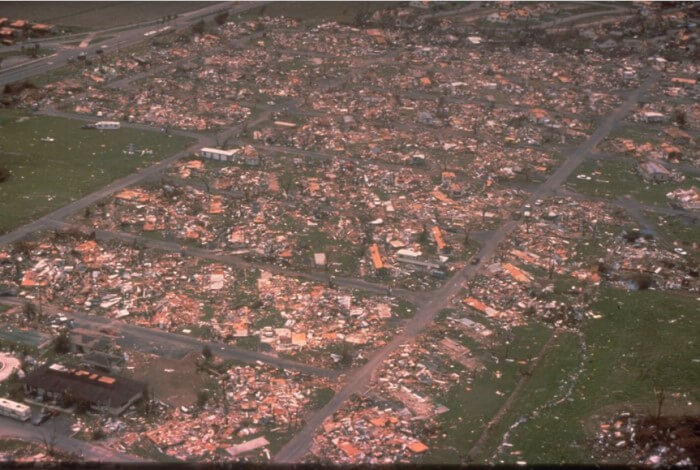 Homestead, Florida After Hurricane Andrew
Homestead, Florida After Hurricane AndrewHurricane Andrew made landfall in Homestead on August 24, 1992, as a Category 5 storm with wind speeds of 165 mph, property damage of $27 billion, and 65 lives lost. I moved into Miami two weeks later to assist in hurricane recovery and rebuilding. The devastation was overwhelming. There was almost no housing available, so I lived on my boat at Miami Beach Marina.
Hurricane Opal hit Pensacola Beach, on October 4, 1995, as a Category 3 storm with wind speeds of 115 mph, storm surge of 10-15 feet, property damage of $4.7 billion, and 59 lives lost.
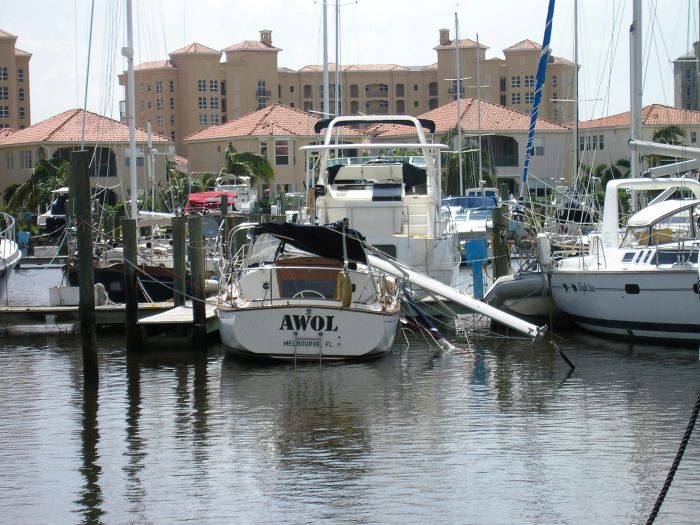 AWOL After Hurricane Charley
AWOL After Hurricane CharleyHurricane Charley struck Cayo Costa on August 13, 2004, as a Category 4 storm with wind speeds of 150 mph, storm surge of 6-8 feet, property damage of $16 billion, much of it in Punta Gorda, and 15 lives lost. My Island Packet sailboat, AWOL, was badly damaged by this hurricane while in her slip at Burnt Store Marina south of Punta Gorda.
Hurricane Frances made landfall in Sewall's Point in Stuart, on September 5, 2004, as a Category 2 storm with wind speeds of 105 mph, storm surge of 5-8 feet, property damage of $10 billion, and 7 lives lost.
Hurricane Ivan made landfall as a Category 3 hurricane close to Pensacola in Gulf Shores, Alabama on September 16, 2004 with winds of 130 mph. The storm did tremendous damage in the Caribbean with $26 billion in property damage including $20.5 billion in the US. 64 people were killed in the Caribbean and 25 in the United States, 14 of them in Florida.
Hurricane Jeanne hit Hutchinson Island, Florida, on September 26, 2004, as a Category 3 storm with wind speeds of 120 mph, storm surge of 5-7 feet, property damage of $7.5 billion, and 3,037 lives lost in Haiti, Puerto Rico including 5 in the US.
Many Floridians will never forget 2004. Four hurricanes kept the state in turmoil from August through September: Charley, Frances, Ivan, and Jeanne.
It was difficult to decide whether to run or stay during this confusing period. The National Hurricane Center of the National Weather Service had its hands full keeping track of things.
I had two real estate closings delayed: one for the sale of my house in Melbourne, Florida and the other for the purchase of my new home in Naples, Florida. My boat was badly damaged by Charley.
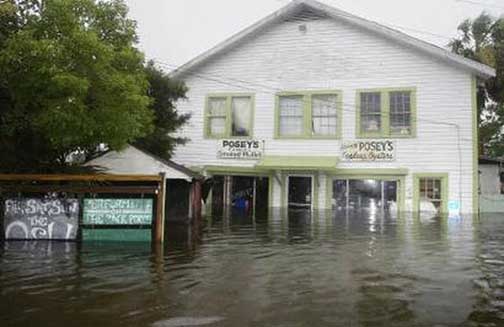 Posey's Oyster Bar, St. Marks, After Dennis
Posey's Oyster Bar, St. Marks, After DennisHurricane Dennis made landfall on Santa Rosa Island on the Florida Panhandle Gulf Coast on July 10, 2005, as a Category 3 storm with wind speeds of 120 mph, storm surge of 7-9 feet, severe damage of at $2.5 billion, and 15 lives lost.
Hurricane Wilma struck Cape Romano, Florida, on October 24, 2005, as a Category 3 storm with wind speeds of 120 mph, storm surge of 5-8 feet, property damage of $19 billion, and 5 lives lost.
Hurricane Irma hit Cudjoe Key, Florida, on September 10, 2017, as a Category 4 storm with wind speeds of 130 mph, storm surge of 5-10 feet, property damage of $50 billion, and 84 lives lost.
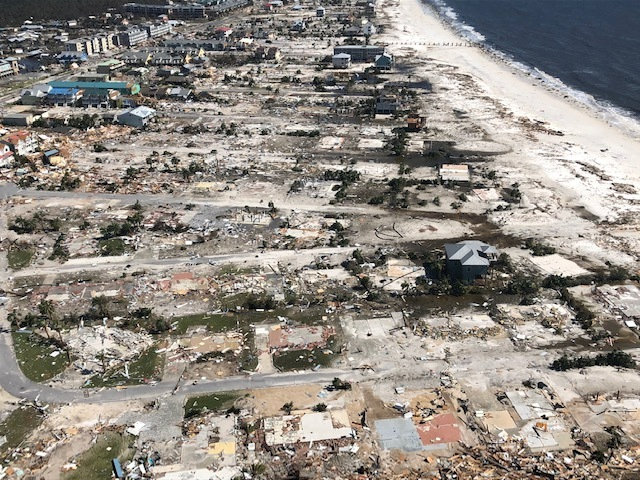 Mexico Beach After Hurricane Michael
Mexico Beach After Hurricane MichaelHurricane Michael made landfall in Mexico Beach, Florida, on October 10, 2018, as a Category 4 storm with wind speeds of 155 mph, storm surge of 9-14 feet, property damage of $25 billion, and 49 lives lost. It almost totally destroyed Mexico Beach and did major damage to towns inland in the Panhandle.
Hurricane Sally struck near Pensacola with its landfall in Gulf Shores, Alabama, on September 16, 2020, as a Category 2 storm with wind speeds of 105 mph, storm surge of 4-7 feet, property damage of $7.3 billion, and 8 lives lost. It had gathered strength before landfall because of its long path over the Gulf.
This time lapse webcam shows the devastion from Hurricane Ian in Fort Myers Beach, Florida.
Hurricane Ian made landfall near Cayo Costa on September 28, 2022 as a Category 5 storm with wind speeds of 157 mph or more and a storm surge of 15 feet. It did extensive damage to Fort Myers Beach, Sanibel, and Captiva along with other Southwest Florida communities including Pine Island.
Hurricane Nicole made landfall near Vero Beach on November 10, 2022 as a Category 1 storm with maximum wind speeds of 75 mph and heavy rainfall. It caused severe beach erosion in Volusia, St. Johns, and Flagler counties. It caused 5 deaths in Florida.
Hurricane Idalia – A powerful Category 3 storm after undergoing rapid intensification in the Gulf, Idalia made landfall on August 30, 2023 in the Big Bend region of Florida with winds of 115 mph, pressure of 942 mb, causing at least 12 fatalities and $3.5 billion in damage . The storm affected coastal and inland communities with destructive winds and storm surge.
Hurricane Debby – A Category 1 hurricane that struck near Steinhatchee, Florida on August 5, 2024. Heavy rainfall—up to 20 inches—triggered widespread flooding and spawned multiple tornadoes. The storm caused 18 deaths and $4.5 billion in damage.
Hurricane Helene – A Category 4 hurricane that struck Florida’s Big Bend near Perry on September 26, 2024 with 120 mph winds and 939 mb pressure. It caused 34 deaths, left over 1 million without power, and inflicted over $13.9 billion in damage . The strongest to ever hit that region; storm surge exceeded 15 feet in places.
Hurricane Milton – A Category 5 hurricane forming over the Gulf and making landfall on Florida's west coast on October 9, 2024 with 155 mph winds, pressure of 895 mb—tying Gulf intensity records. 45 deaths (42 in Florida), and estimated $34.3 billion in damage . Storm surge, wind damage, and flooding affected Tampa Bay, Orlando, and surrounding areas.
Cumulative impact of 2024 Hurricanes – Florida experienced three major hurricanes (Debby, Helene, Milton) in just over 12 months. The combined agricultural losses are estimated at $1.5–2.5 billion, with total storm-related damages between $31–34 billion. Communities, particularly in the Big Bend, faced repeated devastation, displacement, failed insurance, and escalating recovery challenges.
Season Outlook – NOAA and Colorado State University forecast the 2025 Atlantic hurricane season to be above normal, with 13–19 named storms, 6–10 hurricanes, and 3–5 major hurricanes expected . Florida remains on alert as the season progresses.
This list constantly changes from year to year. Now, here's our list of 10 Florida cities safest from hurricanes
SOME HURRICANE MEMORIES FROM READERS
July 7, 2025
Hurricane Michael was reclassified as a category 5 hurricane after investigation. It's really good article on hurricanes I live in Panama City Florida. If you check the record you'll find that hurricane Michael in 2018 reached 160 mph, making it the strongest hurricane on record in the state.
Regards,
Larry Gordon
July 7, 2025
Hi Mike. Just read your Florida Hurricane History writeup, and it revived a lot of memories of my years in Florida. I, too, was a new resident when my family moved from North Carolina to the Jacksonville area in spring of 1960, when I was 9 years old.
We lived in a mobile home in a park off Beach Blvd. near the Intracoastal Waterway. When hurricane Donna was approaching, we piled into the family Rambler station wagon and headed North; don't remember where we ended up. Fortunately, we returned to find little damage to our home.
Fast forward to August, 2004, and hurricane Charley. My wife and I lived in Largo. Forecasts had Charley making landfall a bit north of Tampa Bay, meaning it's counterclockwise rotation would have impacted the Bay area heavily.
Being the hurricane chicken that I am, I convinced the wife we should evacuate. We went inland to Kissimmee, where we were lucky to find an available hotel room.
All settled in, we started seeing news reports that Charley had started veering right down near Ft. Myers I think it was. It went across the center of the state, with the eye of the storm going right over the hotel we were in!
No major damage, but downed trees blocked us from leaving for a few hours the next day. After that adventure, our friends asked us to let them know when we were evacuating and in which direction, and they'd go the opposite way.
We moved to the Blue Ridge Mountains foothills in western North Carolina in 2014 after retiring. Years later came hurricane Helene.
We were fortunate to not have any severe damages other than some downed trees and several days without electrical power, but as you know, further west in the state suffered catastrophic damages. They are still working to return to normal.
Thank you for your stories about Florida! I almost always gat a "Hey! I remember that!" moment.
Regards,
Jack Mangold
July 7, 2025:
I have only lived in FL for 9 of my 72 years, but I still recall Donna in "safe" Orlando. Her winds forced a bicycle into a storm drain in front of my house, creating a pond that our parents struggled to keep the kids out of.
Until Helene, every hurricane in Citrus County was measured by the "No Name" storm that did tremendous damage to the coastal area in 1993 that is still visible.
Sincerely,
Penny Gaffney

Florida is the fastest-growing state in the United States and also the fastest-changing. If you see anything in this article that has changed or is in error, please let me know.
Thousands of Florida fans subscribe to our free daily Ezine, Florida Heritage Travel and we have 130,000 followers on Facebook.
By Mike Miller, Copyright 2009-2025
Florida-Back-Roads-Travel.com
Florida Back Roads Travel is not affiliated with or endorsed by Backroads, a California-based tour operator which arranges and conducts travel programs throughout the world.
